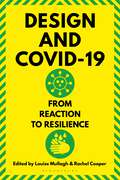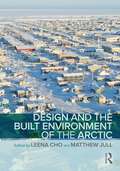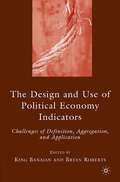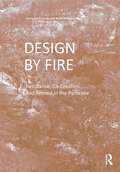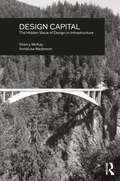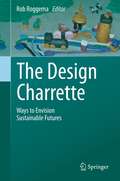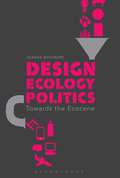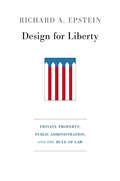- Table View
- List View
Design and Covid-19: From Reaction to Resilience
Presenting key examples and case studies of how design has responded to the pandemic, Design and Covid-19 offers lessons and approaches to design for future resilience. Design has a key role to play in not only creating products to ensure safety from the pandemic, but also in the creation of complex systems, new technologies and physical environments that enable us to carry out our lives and protect populations in the future. Design and Covid-19 identifies four key phases of the pandemic to examine how designers developed systems, services, communications and products as part of our response to the crisis, whether at an international, national or community level. Contributors report from a range of international contexts, including countries in Europe, Asia, Africa and Australasia, detailing how countries responded to the pandemic, introduced social distancing and lockdowns, developed test, track and trace systems, implemented new laws and how design and designers responded to the urgent new challenges that the pandemic created. They explore the adaptation of designs as communities searched for new ways of connecting and working through restrictions and social distancing measures, establishing local mutual aid groups and using social media to support each other through the pandemic, and go on to focus on recovery and resilience, analysing the deeper, systemic design response as industries emerge from lockdown. They explore the need to reflect on and investigate key issues in order to understand what we can learn personally, socially, economically and globally from this unprecedented crisis. Drawing upon the expertise of scholars from across the globe, Design and Covid-19 explores a wide range of design disciplines to address the complex societal and global issues highlighted throughout the pandemic, and to inform new ways of building human and planetary wellbeing.
Design and Management of Sustainable Built Environments
by Runming YaoClimate change is believed to be a great challenge to built environment professionals in design and management. An integrated approach in delivering a sustainable built environment is desired by the built environment professional institutions. The aim of this book is to provide an advanced understanding of the key subjects required for the design and management of modern built environments to meet carbon emission reduction targets. In Design and Management of Sustainable Built Environments, an international group of experts provide comprehensive and the most up-to-date knowledge, covering sustainable urban and building design, management and assessment. The best practice case studies of the implementation of sustainable technology and management from the BRE Innovation Park are included. Design and Management of Sustainable Built Environments will be of interest to urban and building designers, environmental engineers, and building performance assessors. It will be particularly useful as a reference book for undergraduate and postgraduate students in the built environment field.
Design and Reform of Taxation Policy (Financial and Monetary Policy Studies #25)
by P. Galeotti Massimo MarrelliG. Galeotti* and M. Marrelli** *Universita di Perugia **Universita di Napoli 1. The economic analysis of optimal taxation has permitted considerable steps to be taken towards the understanding of a number of problems: the appropriate degree of progression, the balance between different taxes, the equity-efficiency trade-off etc .. Though at times considered as abstract and of little use in policy design, the issues it addresses are real ones and very much on the agenda of many countries. As usual in scientific debate, criticisms have contributed to the correct understanding of the theoretical problems involved and made clear that, at the present state of the art, definitive conclusions may be premature. A first well-taken criticism addresses the assumption, underlying optimal taxation models, of a competitive economy with perfect information on the part of individual agents and full market clearing. Once we leave the Arrow-Debreu world, it is no longer necessarily the case that taxes and transfers introduce distortions on otherwise efficient allocations.
Design and the Built Environment of the Arctic
by Leena Cho Matthew JullDesign and the Built Environment of the Arctic is a concise introductory guide to the design and planning of the built environments in the Arctic region. As the global forces of change are becoming more pronounced in the Arctic, the future trajectories for living environments, city-making processes, and their adaptive capacities need to be addressed directly. This book presents 11 new and original contributions from both leading and emerging scholars and practitioners, positioning the Arctic as a dynamic, diverse, and lived place at the nexus of unprecedented socioenvironmental transformations. The volume offers key concepts for understanding and spatializing Arctic cities and landscapes; similarities and differences in the development of design and planning approaches responsive to specific climatic and cultural conditions; and historical and geographic case studies that provide unique perspectives for the management of the built environment, from the scales of a building and infrastructure to cities and territories. Altogether, the contributions expand regional Arctic design scholarship to understand how the variability of the Arctic context influences the designed urban, architecture, and landscape systems, and offer numerous lessons for design and other forms of spatial practice both within and beyond the Arctic. This is a unique resource for researchers, creative practitioners, policymakers, and community decision-makers, as well as for advanced undergraduate and graduate students.
Design and the Built Environment of the Arctic
Design and the Built Environment of the Arctic is a concise introductory guide to the design and planning of the built environments in the Arctic region. As the global forces of change are becoming more pronounced in the Arctic, the future trajectories for living environments, city-making processes, and their adaptive capacities need to be addressed directly. This book presents 11 new and original contributions from both leading and emerging scholars and practitioners, positioning the Arctic as a dynamic, diverse, and lived place at the nexus of unprecedented socioenvironmental transformations. The volume offers key concepts for understanding and spatializing Arctic cities and landscapes; similarities and differences in the development of design and planning approaches responsive to specific climatic and cultural conditions; and historical and geographic case studies that provide unique perspectives for the management of the built environment, from the scales of a building and infrastructure to cities and territories. Altogether, the contributions expand regional Arctic design scholarship to understand how the variability of the Arctic context influences the designed urban, architecture, and landscape systems, and offer numerous lessons for design and other forms of spatial practice both within and beyond the Arctic. This is a unique resource for researchers, creative practitioners, policymakers, and community decision-makers, as well as for advanced undergraduate and graduate students.
The Design and Use of Political Economy Indicators: Challenges of Definition, Aggregation, and Application
by K. Banaian B. RobertsThis edited volume seeks to provide a critical and technical look at international political economic indices (PEIs). It examines measurement issues, relates PEIs to economic theory, and suggests better measures than those currently used.
Design as Democracy: Techniques for Collective Creativity
by David Peña, Diane Jones Allen, Randolph T. Hester, Jeffrey Hou, Laura L. Lawson and Marcia J. McNallyEdited by six leading practitioners and academics in the field of participatory design, with nearly 50 contributors from around the world, this book shows how to design with communities in empowering and effective ways. The flow of the book’s nine chapters reflects the general progression of community design process, while also encouraging readers to search for ways that best serve their distinct needs and the culture and geography of diverse places. Each chapter presents a series of techniques around a theme, from approaching the initial stages of a project, to getting to know a community, to provoking political change through strategic thinking. Readers may approach the book as they would a cookbook, with recipes open to improvisation, adaptation, and being created anew.
Design as Future-Making
by Susan Yelavich Barbara AdamsDesign as Future-Making brings together leading international designers, scholars, and critics to address ways in which design is shaping the future. The contributors share an understanding of design as a practice that, with its focus on innovation and newness, is a natural ally of futurity. Ultimately, the choices made by designers are understood here as choices about the kind of world we want to live in. Design as Future-Making locates design in a space of creative and critical reflection, examining the expanding nature of practice in fields such as biomedicine, sustainability, digital crafting, fashion, architecture, urbanism, and design activism. The authors contextualize design and its affects within issues of social justice, environmental health, political agency, education, and the right to pleasure and play. Collectively, they make the case that, as an integrated mode of thought and action, design is intrinsically social and deeply political.
Design as Future-Making
by Susan Yelavich Barbara AdamsDesign as Future-Making brings together leading international designers, scholars, and critics to address ways in which design is shaping the future. The contributors share an understanding of design as a practice that, with its focus on innovation and newness, is a natural ally of futurity. Ultimately, the choices made by designers are understood here as choices about the kind of world we want to live in. Design as Future-Making locates design in a space of creative and critical reflection, examining the expanding nature of practice in fields such as biomedicine, sustainability, digital crafting, fashion, architecture, urbanism, and design activism. The authors contextualize design and its affects within issues of social justice, environmental health, political agency, education, and the right to pleasure and play. Collectively, they make the case that, as an integrated mode of thought and action, design is intrinsically social and deeply political.
Design by Fire: Resistance, Co-Creation and Retreat in the Pyrocene
by Emily Schlickman Brett MilliganAcross the world, the risks of wildfires are increasing and expanding. Due to past and current human actions, we dwell in the age of fire – the Pyrocene – and the many challenges and climate adaptation questions it provokes. Exploring our past and current relationships with fire, this book speculates on the pyro futures yet to be designed and cared for.Drawing upon fieldwork, mapping, drone imagery, and interviews, this publication curates 27 global design case studies within the vulnerable and dynamic wildland-urban interface and its adjacent wildlands. The book catalogs these examples into three approaches: those that resist the creative and transformative power of fire and forces of landscape change, those that embrace and utilize those forces, and those that intentionally try to retreat and minimize human intervention in fire-prone landscapes. Rather than serving as a book of neatly packaged solutions, it is a book of techniques to be considered, tested, and evaluated in a time of fire.
Design by Fire: Resistance, Co-Creation and Retreat in the Pyrocene
by Emily Schlickman Brett MilliganAcross the world, the risks of wildfires are increasing and expanding. Due to past and current human actions, we dwell in the age of fire – the Pyrocene – and the many challenges and climate adaptation questions it provokes. Exploring our past and current relationships with fire, this book speculates on the pyro futures yet to be designed and cared for.Drawing upon fieldwork, mapping, drone imagery, and interviews, this publication curates 27 global design case studies within the vulnerable and dynamic wildland-urban interface and its adjacent wildlands. The book catalogs these examples into three approaches: those that resist the creative and transformative power of fire and forces of landscape change, those that embrace and utilize those forces, and those that intentionally try to retreat and minimize human intervention in fire-prone landscapes. Rather than serving as a book of neatly packaged solutions, it is a book of techniques to be considered, tested, and evaluated in a time of fire.
Design Capital: The Hidden Value of Design in Infrastructure
by Sherry McKay AnnaLisa MeyboomWell-designed infrastructure brings social value that far exceeds its initial construction expenditure, but competition for scarce government funds and a general public perception of infrastructure as mere efficiency, has often left design ill-considered. This book provides designers with the tools needed to argue for the value of design: the ‘design capital’ as the authors term it. In naming and defining design capital, design can once again become part of the discussion and realization of every infrastructure project.Design Capital offers strategies and tools for justifying public spending on design considerations in infrastructure projects. Design has the ability to make infrastructure resonate with cultural or social value, as seen in the case studies, which bestows infrastructure with the potential to accrue design capital. Support for this proposition is drawn from various methodologies of economic valuation and Bourdieu’s theory of cultural capital, explanation of design methodology and education and a series of historical and contemporary case studies. The book also addresses some of the more controversial outcomes associated with contemporary infrastructure: gentrification, globalization and consumer tourism.With this book, designers can make a stronger case for the value of design in public infrastructure.
Design Capital: The Hidden Value of Design in Infrastructure
by Sherry McKay AnnaLisa MeyboomWell-designed infrastructure brings social value that far exceeds its initial construction expenditure, but competition for scarce government funds and a general public perception of infrastructure as mere efficiency, has often left design ill-considered. This book provides designers with the tools needed to argue for the value of design: the ‘design capital’ as the authors term it. In naming and defining design capital, design can once again become part of the discussion and realization of every infrastructure project.Design Capital offers strategies and tools for justifying public spending on design considerations in infrastructure projects. Design has the ability to make infrastructure resonate with cultural or social value, as seen in the case studies, which bestows infrastructure with the potential to accrue design capital. Support for this proposition is drawn from various methodologies of economic valuation and Bourdieu’s theory of cultural capital, explanation of design methodology and education and a series of historical and contemporary case studies. The book also addresses some of the more controversial outcomes associated with contemporary infrastructure: gentrification, globalization and consumer tourism.With this book, designers can make a stronger case for the value of design in public infrastructure.
The Design Charrette: Ways to Envision Sustainable Futures
by Rob RoggemaThis book was written to support community involvement in the design process, to help prevent negative outcomes that can result from a top-down design approach. The combination of community involvement and design is, at least in literature, not very extensive. Although much has been written about stakeholder involvement, this is often not directly related to design processes, which – most importantly – deprives community members of the opportunity to design their desired future themselves. The Design Charrette: Ways to Envision Sustainable Futures provides a theoretical foundation establishing the benefits of organizing a design charrette for community-based planning, supported by many practical examples. The book includes sections on collaborative learning, practical guidance, theory and case studies in many different contexts: long and short charrettes, urban and rural subjects, and Dutch, Chinese, Australian, Indian and European examples. Part I: General Theory offers a detailed overview of the charrette process, a chapter on innovations in organizational and community learning and a chapter on shifting paradigms in the design charrette. Part II presents a number of case studies, including the INternational Conference on Renewable Energy Approaches for the Spatial Environment (INCREASE); charrettes accomplished in two days in the communities of Sea Lake and Bendigo in Australia; a chapter on lessons for the future, describing rural participatory design in Rajasthan, India; a description of learning by practice in a high-pressure student atelier; a chapter entitled Design Charrettes for Sustainable Building in China and more. The Design Charrette challenges the conventional wisdom that good design by itself will bring about the benefits the designer envisions. By demonstrating and analyzing the effectiveness of design charrettes in personal development and learning, and as a way to share desired future pathways, the book benefits everyone who may be leading, considering or participating in a design charrette.
Design, Ecology, Politics: Towards the Ecocene
by Joanna BoehnertDesign, Ecology, Politics links social and ecological theory to design theory and practice, critiquing the ways in which the design industry perpetuates unsustainable development.Boehnert argues that when design does engage with issues of sustainability, this engagement remains shallow, due to the narrow basis of analysis in design education and theory. The situation is made more severe by design cultures which claim to be apolitical. Where design education fails to recognise the historical roots of unsustainable practice, it reproduces old errors. New ecologically informed design methods and tools hold promise only when incorporated into a larger project of political change. Design, Ecology, Politics describes how ecological literacy challenges many central assumptions in design theory and practice.By bringing design, ecology and socio-political theory together, Boehnert describes how power is constructed, reproduced and obfuscated by design in ways which often cause environmental harms. She uses case studies to illustrate how communication design functions to either conceal or reveal the ecological and social impacts of current modes of production. The transformative potential of design is dependent on deep-reaching analysis of the problems design attempts to address. Ecologically literate and critically engaged design is a practice primed to facilitate the creation of viable, sustainable and just futures. With this approach, designers can make sustainability not only possible, but attractive.
Design, Ecology, Politics: Towards the Ecocene
by Joanna BoehnertDesign, Ecology, Politics links social and ecological theory to design theory and practice, critiquing the ways in which the design industry perpetuates unsustainable development.Boehnert argues that when design does engage with issues of sustainability, this engagement remains shallow, due to the narrow basis of analysis in design education and theory. The situation is made more severe by design cultures which claim to be apolitical. Where design education fails to recognise the historical roots of unsustainable practice, it reproduces old errors. New ecologically informed design methods and tools hold promise only when incorporated into a larger project of political change. Design, Ecology, Politics describes how ecological literacy challenges many central assumptions in design theory and practice.By bringing design, ecology and socio-political theory together, Boehnert describes how power is constructed, reproduced and obfuscated by design in ways which often cause environmental harms. She uses case studies to illustrate how communication design functions to either conceal or reveal the ecological and social impacts of current modes of production. The transformative potential of design is dependent on deep-reaching analysis of the problems design attempts to address. Ecologically literate and critically engaged design is a practice primed to facilitate the creation of viable, sustainable and just futures. With this approach, designers can make sustainability not only possible, but attractive.
Design First: Design-based Planning For Communities
by David Walters Linda BrownWell-grounded in the history and theory of Anglo-American urbanism, this illustrated textbook sets out objectives, policies and design principles for planning new communities and redeveloping existing urban neighborhoods. Drawing from their extensive experience, the authors explain how better plans (and consequently better places) can be created by applying the three-dimensional principles of urban design and physical place-making to planning problems.Design First uses case studies from the authors’ own professional projects to demonstrate how theory can be turned into effective practice, using concepts of traditional urban form to resolve contemporary planning and design issues in American communities.The book is aimed at architects, planners, developers, planning commissioners, elected officials and citizens -- and, importantly, students of architecture and planning -- with the objective of reintegrating three-dimensional design firmly back into planning practice.
Design First
by David Walters Linda BrownWell-grounded in the history and theory of Anglo-American urbanism, this illustrated textbook sets out objectives, policies and design principles for planning new communities and redeveloping existing urban neighborhoods. Drawing from their extensive experience, the authors explain how better plans (and consequently better places) can be created by applying the three-dimensional principles of urban design and physical place-making to planning problems.Design First uses case studies from the authors’ own professional projects to demonstrate how theory can be turned into effective practice, using concepts of traditional urban form to resolve contemporary planning and design issues in American communities.The book is aimed at architects, planners, developers, planning commissioners, elected officials and citizens -- and, importantly, students of architecture and planning -- with the objective of reintegrating three-dimensional design firmly back into planning practice.
Design for an Empathic World: Reconnecting People, Nature, and Self
by Sim Van der RynDespite an uncertain economy, the market for green building is exploding. The US green building market has expanded dramatically since 2008 and is projected to double in size by 2015 (from $42 billion in construction starts to $135 billion). But green-building pioneer Sim Van der Ryn says, “greening” our buildings is not enough. He advocates for “empathic design”, in which a designer not only works in concert with nature, but with an understanding of and empathy for the end user and for one's self. It is not just one of these connections, but all three that are necessary to design for a future that is more humane, equitable, and resilient.Sim’s lifelong focus has been in shifting the paradigm in architecture and design. Instead of thinking about design primarily in relation to the infrastructure we live in and with—everything from buildings to wireless routing—he advocates for a focus on the people who use and are affected by this infrastructure. Basic design must include a real understanding of human ecology or end-user preferences. Understanding ones motivations and spirituality, Sim believes, is critical to designing with empathy for natural and human communities.In Design for an Empathic World Van der Ryn shares his thoughts and experience about the design of our world today. With a focus on the strengths and weaknesses in our approach to the design of our communities, regions and buildings he looks at promising trends and projects that demonstrate how we can help create a better world for others and ourselves. Architects, urban designers, and students of architecture will all enjoy this beautifully illustrated book drawing on a rich and revered career of a noted leader in their field. The journey described in Design for an Empathic World will help to inspire change and foster the collaboration and thoughtfulness necessary to achieve a more empathic future.
Design for Change: Designing Evidence-Based Teacher Preparation Programs
by Alan BainThis book focuses on enhancing teacher education quality by making evidence- informed decisions about policy, assessing quality, establishing effective strategies, and innovating teacher preparation programs. It advocates for the importance of rigorous program design and evaluation as the basis for shaping policy directions and claiming program effectiveness. The book introduces "Design for Change" (DfC), a 20-year-long collaborative effort by a group of teacher educators dedicated to improving their practices. DfC is divided into two parts: Design for Change-Teams and Process (DfC-TaP) and Design for Change-Programs and Courses (DfC-PaC). DfC-TaP explores how to form and sustain a design team of academics, emphasizing the collaborative process's value in program development. DfC-PaC delves into applying practical theory to curriculum design, mapping programs to standards, creating meaningful learning and assessment tasks, and leveraging technology. The latterincludes a chapter on software for teacher preparation program design. The book's ultimate goal is to offer a versatile framework for designing teacher education programs. The book employs evidence from longitudinal research to present generalizable concepts and structures for program developers and designers. By doing so, the book aims to contribute to the field by providing a research-based guide for building teacher education programs that enhance the overall educational experience for both faculty and students.
Design for Democracy: Ballot and Election Design
by Marcia LausenIn November 2000, when the now-infamous "butterfly ballot" confused crucial Florida voters during a hotly contested presidential race, the importance of well-designed ballots to a functioning democracy caught the nation's attention. Recognizing that our entire voting process—from registering to vote to following instructions at the polling place—can be almost as confusing as the Florida ballot, Design for Democracy builds on the lessons of 2000 by presenting innovative steps for redesigning elections in the service of citizens. Handsomely designed itself, this volume showcases adaptable design models that can improve almost every part of the election process by maximizing the clarity and usability of ballots, registration forms, posters and signs, informational brochures and guides, and even administrative materials for poll workers. Design for Democracy also lays out specific guidelines—covering issues of color palette, typography, and image use—that anchor the comprehensive election design system devised by the group of design specialists from whose name the book takes its title. Part of a major AIGA strategic program, this group's prototypes and recommendations have already been used successfully in major Illinois and Oregon elections and, collected here, are likely to spread across the country as more people become aware of the myriad benefits and broad applicability of improved election design. An essential tool for designers and election officials, lawmakers and citizens, Design for Democracy harnesses the power of design to increase voter confidence, promote government transparency, and, perhaps most important, create an informed electorate.
Design for Democracy: Ballot and Election Design
by Marcia LausenIn November 2000, when the now-infamous "butterfly ballot" confused crucial Florida voters during a hotly contested presidential race, the importance of well-designed ballots to a functioning democracy caught the nation's attention. Recognizing that our entire voting process—from registering to vote to following instructions at the polling place—can be almost as confusing as the Florida ballot, Design for Democracy builds on the lessons of 2000 by presenting innovative steps for redesigning elections in the service of citizens. Handsomely designed itself, this volume showcases adaptable design models that can improve almost every part of the election process by maximizing the clarity and usability of ballots, registration forms, posters and signs, informational brochures and guides, and even administrative materials for poll workers. Design for Democracy also lays out specific guidelines—covering issues of color palette, typography, and image use—that anchor the comprehensive election design system devised by the group of design specialists from whose name the book takes its title. Part of a major AIGA strategic program, this group's prototypes and recommendations have already been used successfully in major Illinois and Oregon elections and, collected here, are likely to spread across the country as more people become aware of the myriad benefits and broad applicability of improved election design. An essential tool for designers and election officials, lawmakers and citizens, Design for Democracy harnesses the power of design to increase voter confidence, promote government transparency, and, perhaps most important, create an informed electorate.
Design for Democracy: Ballot and Election Design
by Marcia LausenIn November 2000, when the now-infamous "butterfly ballot" confused crucial Florida voters during a hotly contested presidential race, the importance of well-designed ballots to a functioning democracy caught the nation's attention. Recognizing that our entire voting process—from registering to vote to following instructions at the polling place—can be almost as confusing as the Florida ballot, Design for Democracy builds on the lessons of 2000 by presenting innovative steps for redesigning elections in the service of citizens. Handsomely designed itself, this volume showcases adaptable design models that can improve almost every part of the election process by maximizing the clarity and usability of ballots, registration forms, posters and signs, informational brochures and guides, and even administrative materials for poll workers. Design for Democracy also lays out specific guidelines—covering issues of color palette, typography, and image use—that anchor the comprehensive election design system devised by the group of design specialists from whose name the book takes its title. Part of a major AIGA strategic program, this group's prototypes and recommendations have already been used successfully in major Illinois and Oregon elections and, collected here, are likely to spread across the country as more people become aware of the myriad benefits and broad applicability of improved election design. An essential tool for designers and election officials, lawmakers and citizens, Design for Democracy harnesses the power of design to increase voter confidence, promote government transparency, and, perhaps most important, create an informed electorate.
Design for Good: A New Era of Architecture for Everyone
by John CaryIn this volume, the author offers character-driven, real-world stories about projects around the globe that offer more—buildings that are designed and created with and for the people who will use them. The book reveals a new understanding of the ways that design shapes our lives and gives professionals and interested citizens the tools to seek out and demand designs that dignify.
Design for Liberty: Private Property, Public Administration, and the Rule of Law
by Richard A. EpsteinFollowing a vast expansion in the twentieth century, government is beginning to creak at the joints under its enormous weight. The signs are clear: a bloated civil service, low approval ratings for Congress and the President, increasing federal-state conflict, rampant distrust of politicians and government officials, record state deficits, and major unrest among public employees. In this compact, clearly written book, the noted legal scholar Richard Epstein advocates a much smaller federal government, arguing that our over-regulated state allows too much discretion on the part of regulators, which results in arbitrary, unfair decisions, rent-seeking, and other abuses. Epstein bases his classical liberalism on the twin pillars of the rule of law and of private contracts and property rights—an overarching structure that allows private property to keep its form regardless of changes in population, tastes, technology, and wealth. This structure also makes possible a restrained public administration to implement limited objectives. Government continues to play a key role as night-watchman, but with the added flexibility in revenues and expenditures to attend to national defense and infrastructure formation. Although no legal system can eliminate the need for discretion in the management of both private and public affairs, predictable laws can cabin the zone of discretion and permit arbitrary decisions to be challenged. Joining a set of strong property rights with sound but limited public administration could strengthen the rule of law, with its virtues of neutrality, generality, clarity, consistency, and forward-lookingness, and reverse the contempt and cynicism that have overcome us.
